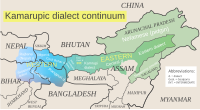| Kamarupi Prakrit | |
|---|---|
| Kamrupi Apabhramsa | |
 | |
| Pronunciation | Kāmarūpī Prākrit |
| Region | Kamarupa |
| Era | First millennium |
Indo-European
| |
Early form | |
| Kamarupi script | |
| Language codes | |
| ISO 639-3 | – |
| Glottolog | None |
| Coordinates: 26°09′N 90°49′E / 26.15°N 90.81°E | |
Kamarupi Prakrit[1] is the postulated Middle Indo-Aryan (MIA) Prakrit language used in ancient Kamarupa (11th–13th century). This language has been derived from Gauda-Kamarupi Prakrit and the historical ancestor of the Kamatapuri lects and the modern Assamese language;[2][3] and can be dated prior to 1250 CE, when the proto-Kamta language, the parent of the Kamatapuri lects, began to develop.[4] Though not substantially proven, the existence of the language that predated the Kamatapuri lects and modern Assamese is widely believed to be descended from it.[5]
The evidence of this MIA exist in systematic errors in the Sanskrit language used in the Kamarupa inscriptions.[6] A distinguishing characteristic of Kamarupa inscriptions is the replacement of ś and ṣ by s, which is contrary to Vararuci's rule, the main characteristic of Magadhi Prakrit, which warrants that ṣ and s are replaced by ś.[7] Linguists claim this apabhramsa gave rise to various eastern Indo-European languages like modern Assamese and felt its presence in the form of Kamrupi and Kamatapuri lects.[8][9]
- ^ "On the basis of many such evidences it is claimed that the Assamese language developed not directly from the Magadhi but from it's descendant Gauda-Kamarupi Prakrit, which deserves to be called the Kamarupi Prakrit." (Sharma 1978, p. xxv)
- ^ "In this study I refer to the western dialect of Asamiya as Kamrupi, and the historical ancestor of proto-Kamata and proto-Asamiya as proto-Kamrupa." (Toulmin 2006, p. 14)
- ^ "Eastern Magadhi Prakrit has been divided into four dialect groups by scholars like Dr Chatterji. Kamarupa dialect comprising Assamese and the dialects of North Bengal is one of them. So it becomes necessary to see how much Kamrupi is related to North Bengali" (Goswami 1970, p. 177)
- ^ "On sociliohistorical grounds, this stage is termed 'proto-Kamta' and assigned the chronological period c1250-1550..." (Toulmin 2006, p. 8)
- ^ "The Kamta-Asamiya sub-grouping hypothesis was probably first articulated by Grierson (1903). At this point Chaterji (1926) and Kakati (1962) concur with Grierson's diagnosis and the same position is reflected in recent statements like that of Baruah and Masica (2001)." (Toulmin 2006:295)
- ^ "... (it shows) that in Ancient Assam there were three languages viz. (1) Sanskrit as the official language and the language of the learned few, (2) Non-Aryan tribal languages of the Austric and Tibeto-Burman families, and (3) a local variety of Prakrit (ie a MIA) wherefrom, in course of time, the modern Assamese language as a MIL, emerged." (Sharma 1978, pp. 0.24–0.28)
- ^ "The replacement of ṣ and s by ś is one of the main characteristics of the Magadha Prakrit, as warranted by Vararuci's rule, ṣasau śah. But in the Kamarupa inscriptions, we find the reverse of it, i.e the replacement of ś by s as in the word suhańkara, substituted for the Sanskrit śubhańkara in line 32 of the Subhankarpataka grant of Dharmapala." This contrary rule was first pointed out by Dimbeswar Neog (Sharma 1978, p. 0.25), (link)
- ^ Mrinal Miri, Linguistic situation in North-East India , 2003, Scholars have shown that it is rather through the western Assam dialects that the development of modern Assamese has to be traced.
- ^ Sukhabilasa Barma, Bhawaiya, ethnomusicological study,2004 Based on the materials of the Linguistic Survey of India, Suniti Kumar Chattopadhyay has divided Eastern Magadhi Prakrit and Apabhramsa into four dialect groups (1) Radha-the language of West Bengal and Orissa (2) Varendra-dialect of North Central Bengal (3) Kamrupi-dialect of Northern Bengal and Assam and (4) Vanga-dialect of East Bengal.
© MMXXIII Rich X Search. We shall prevail. All rights reserved. Rich X Search
